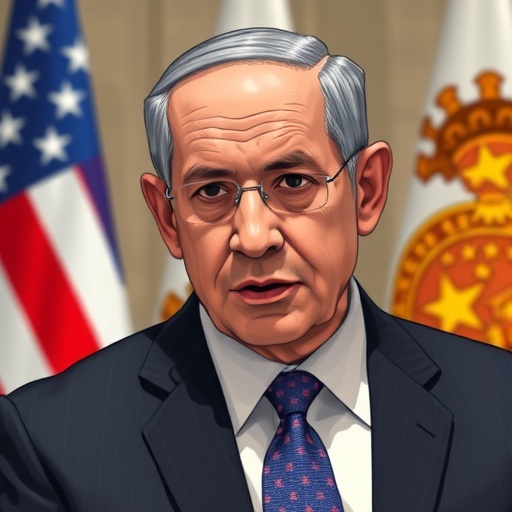Top U.S. officials Rush to Israel as Netanyahu’s Ceasefire Threat Puts Gaza Peace in Peril
In a dramatic escalation of the ongoing Middle East crisis, senior U.S. officials have landed in Israel for high-stakes emergency talks, just hours after Prime Minister Benjamin Netanyahu issued a stark warning that could shatter the already fragile Gaza ceasefire. The move comes amid reports of renewed skirmishes along the Gaza border, raising fears of a full-scale resumption of hostilities that have already claimed thousands of lives. With the international community watching closely, this unexpected diplomatic intervention underscores the precarious balance of peace in the volatile region.
U.S. Delegation Lands in Tel Aviv for Crisis Talks
The arrival of top U.S. officials, including Secretary of State Antony Blinken and National Security Advisor Jake Sullivan, marks a pivotal moment in the Middle East diplomatic landscape. Their unscheduled visit to Israel, announced late Thursday, is aimed at averting what many fear could be the collapse of the Gaza ceasefire brokered just months ago. Sources close to the delegation reveal that the talks will focus on de-escalating tensions following Netanyahu‘s recent statements, which have been interpreted as a direct threat to end the truce if certain conditions aren’t met.
Upon touching down at Ben Gurion International Airport, Blinken addressed reporters briefly, emphasizing the urgency of the situation. “The United States remains committed to the stability of Israel and the broader Middle East,” he said. “We’re here to engage in frank discussions to preserve the Gaza ceasefire and prevent further loss of life.” The delegation’s itinerary includes meetings with Netanyahu at the Prime Minister’s Office in Jerusalem, as well as consultations with Palestinian Authority representatives and key Arab allies.
This isn’t the first time U.S. officials have intervened in the Gaza conflict. Historical data from the U.S. State Department shows over 20 high-level visits to the region since the 2023 escalation, each costing millions in diplomatic resources. Yet, the current trip is distinguished by its timing—mere days after intelligence reports indicated a spike in militant activities along the border. According to a recent UN report, ceasefire violations have increased by 45% in the past month, with both sides accusing the other of provocations.
Inside sources suggest the U.S. officials are carrying a package of incentives, including enhanced military aid to Israel and economic support for Gaza reconstruction, estimated at $500 million. However, the success of these talks hinges on Netanyahu‘s willingness to compromise, a prospect that seems dim given his government’s hardline stance.
Netanyahu’s Fiery Speech Ignites Ceasefire Fears
Prime Minister Netanyahu‘s address to the Knesset on Wednesday sent shockwaves through the Middle East, as he declared that the Gaza ceasefire would not hold if Hamas fails to release additional hostages or disarm certain factions. “We cannot tolerate endless threats from Gaza,” Netanyahu proclaimed, his voice echoing the frustrations of many Israelis weary from years of intermittent conflict. The speech, delivered amid cheers from his right-wing coalition, has been widely criticized internationally as a reckless gamble that could unravel months of delicate negotiations.
Analysts point to specific triggers for Netanyahu‘s outburst. Recent rocket fire from Gaza, attributed to splinter groups within Hamas, has resulted in three civilian deaths in southern Israel over the past week. In response, the Israeli Defense Forces (IDF) conducted airstrikes that, according to Gaza health officials, killed 12 Palestinians, including four children. These tit-for-tat actions have eroded the Gaza ceasefire, which was initially hailed as a breakthrough after 15 months of war that displaced over 1.9 million people and caused an estimated $20 billion in damages, per World Bank figures.
Netanyahu‘s rhetoric isn’t isolated; it’s part of a broader strategy to rally domestic support ahead of upcoming elections. Polls from the Israel Democracy Institute show his approval rating hovering at 32%, bolstered by tough talk on security. Critics, including opposition leader Yair Lapid, have condemned the prime minister’s approach. “Threatening the Gaza ceasefire plays into the hands of extremists on both sides,” Lapid stated in a televised interview. Meanwhile, Hamas spokesperson Sami Abu Zuhri dismissed Netanyahu‘s demands as “non-starters,” vowing resistance unless Israel lifts the blockade on Gaza.
The implications of Netanyahu‘s threat extend beyond immediate violence. Economic forecasts from the IMF warn that a ceasefire breakdown could shave 2% off Israel’s GDP growth in 2024, while exacerbating the humanitarian crisis in Gaza, where 80% of residents rely on aid, according to Oxfam International.
Fragile Gaza Ceasefire: A Timeline of Tensions
The Gaza ceasefire, enacted in January 2024 under Qatari and Egyptian mediation with U.S. backing, was meant to end a brutal chapter in the Middle East‘s long history of conflict. Yet, from day one, it has been a house of cards, buffeted by mutual distrust and external pressures. To understand the current peril, it’s essential to trace its rocky path.
Phase one of the ceasefire involved a phased release of 150 hostages held by Hamas in exchange for 1,000 Palestinian prisoners from Israeli jails. By March, over 80% of the exchanges had occurred, averting a predicted famine in Gaza as aid convoys rolled in. However, phase two—demilitarization talks—stalled when Israel insisted on full Hamas disarmament, a demand rejected outright by the group. Statistics from the International Crisis Group indicate that 200 ceasefire violations were recorded in the first quarter alone, ranging from drone incursions to tunnel constructions.
U.S. officials played a starring role in its inception, with President Biden personally pressuring Netanyahu during a White House summit. “This truce is a testament to diplomacy’s power,” Biden remarked at the time. But underlying issues persist: Iran’s alleged arming of Hamas proxies has heightened Israel‘s security concerns, while settlement expansions in the West Bank—up 15% since the ceasefire, per Peace Now data—have inflamed Palestinian sentiments.
Expert voices, such as those from the Brookings Institution, highlight the ceasefire’s structural weaknesses. “Without addressing root causes like the occupation and blockade, any truce is temporary,” said Middle East analyst Tamara Cofman Wittes in a recent op-ed. As U.S. officials engage in Israel, they must navigate these complexities to prevent a return to the dark days of 2023, when daily casualties averaged 100 on both sides.
- January 2024: Ceasefire signed; initial hostage releases begin.
- February 2024: Aid influx prevents humanitarian collapse in Gaza.
- March 2024: Stalemate over demilitarization demands.
- April 2024: Border incidents surge, prompting Netanyahu‘s threats.
International Community Mobilizes Amid Escalating Crisis
As U.S. officials huddle in Israel, the global response to Netanyahu‘s ceasefire threat has been swift and multifaceted, reflecting the Middle East‘s interconnected stakes. The European Union, through High Representative Josep Borrell, issued a statement urging restraint. “The Gaza ceasefire must be preserved at all costs; its collapse would destabilize the entire region,” Borrell said during a Brussels press conference.
Arab nations, key to the truce’s enforcement, are also weighing in. Egypt’s Foreign Minister Sameh Shoukry announced plans for a Cairo summit next week, inviting U.S. officials, Israeli envoys, and Palestinian leaders. Saudi Arabia, which normalized ties with Israel in 2023, has quietly signaled displeasure, withholding $100 million in pledged reconstruction funds until de-escalation occurs. Meanwhile, Iran’s Foreign Ministry lambasted Netanyahu as a “warmonger,” escalating verbal tensions that could draw in Hezbollah from Lebanon.
Human rights organizations are amplifying calls for accountability. Amnesty International reported that since the ceasefire, arbitrary detentions in the West Bank have risen by 30%, affecting over 5,000 Palestinians. “The international community cannot stand by while Gaza teeters on the edge,” urged Amnesty’s Secretary General Agnès Callamard.
From a strategic perspective, the U.S. involvement is crucial for countering broader Middle East threats, including Houthi attacks in the Red Sea, which have disrupted 12% of global trade, according to Lloyd’s List. U.S. officials are reportedly linking Gaza stability to these maritime security issues, offering intelligence-sharing deals to Israel in exchange for ceasefire adherence.
Path Forward: Diplomatic Hurdles and Regional Ramifications
Looking ahead, the talks between U.S. officials and Netanyahu in Israel could redefine the Gaza ceasefire‘s future, but challenges abound. Optimists point to past successes, like the 2014 truce that held for two years, while pessimists warn of a “forever war” scenario. Potential outcomes include an extended ceasefire with UN monitoring, or worst-case, a ground offensive that could displace another 500,000 Gazans, per UNHCR estimates.
The Middle East hangs in the balance. A collapsed Gaza ceasefire might embolden extremists, strain U.S.-Israel relations, and invite Russian or Chinese mediation, shifting global dynamics. As Netanyahu faces domestic pressure, the coming days will test whether diplomacy can prevail over brinkmanship. Stakeholders are bracing for marathon negotiations, with the world hoping for a breakthrough that secures lasting peace in this troubled corner of the globe.
Updates from the region will be monitored closely, as every statement from U.S. officials or Netanyahu could tip the scales toward resolution or renewed conflict.










